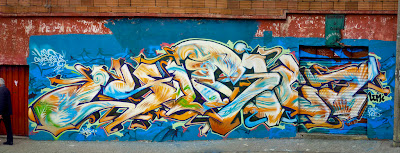"We shall not cease from exploration and the end of all our exploring will be to arrive where we started and know the place for the first time."
T. S. Eliot
The Call: I’m working on a series called "Call and Response". It’s about dialogue. I would appreciate it if you would participate. Just send 2-4 pieces of evidence. It could be images of your work, work you like, things you find interesting.
The Response:
The Response:
From: jrs219@gmail.com
Subject: Evidence
Date: December 25, 2011 3:25:15 PM EST
To: tomschulzartist@gmail.com
Subject: Evidence
Date: December 25, 2011 3:25:15 PM EST
To: tomschulzartist@gmail.com

Detail from The Book of Kells
#1. Interlacing / Intertwining: The Book of Kells and Wildstyle Graffiti
Lately, I've thought quite a bit about the interlacing of elements found in early medieval illuminated manuscripts such as The Book of Kells and how those images may have influenced graffiti artists in the creation of Wildstyle graffiti pieces. I've enjoyed experimenting with similar methods of intertwining on occasion and will continue this pursuit because I am absolutely fascinated by the history and the process.
Lately, I've thought quite a bit about the interlacing of elements found in early medieval illuminated manuscripts such as The Book of Kells and how those images may have influenced graffiti artists in the creation of Wildstyle graffiti pieces. I've enjoyed experimenting with similar methods of intertwining on occasion and will continue this pursuit because I am absolutely fascinated by the history and the process.
#2. Subtractive Synthesis, Video Feedback Loops, Videodrome and Marshall McLuhan. I have enjoyed learning subtractive synthesis over the past few years and it has been extremely rewarding to me. I love the immediacy of hitting a key and hearing a sound as well as the idea of sculpting sound from a basic tone, much like a sculptor starts with a block of wood or marble. I have also enjoyed experimenting with video feedback loops (with a cheap movie camera pointed towards an old analog set) and seeing waves of color and shapes cascade forward as I adjust settings on a video enhancer. This particular interest was rekindled recently after re-watching the David Cronenberg film Videodrome. I think there are some very interesting ideas (though not for the squeamish) there concerning technology and how it can change us both psychologically and physically. I also find it interesting that the director modeled the character Brian O'Blivion after Marshall McCluhan who championed the idea that human inventions were extensions of the human body, like the gun being an extension of the human hand, the wheel (or car) being an extension of the foot, and so on. I feel that as our devices become increasingly focused on the self, a closed loop is formed much like a video feedback loop. An extension of the self presenting the self to the self, folding in on itself...
And here is a clip from the film Videodrome (1983), David Cronenberg.
 tomschulzartist responds: somehow or another I've become a kefir guy. Which is no real surprise, seeing as I started out in my hippied youth as a yogurt guy (having stolen a copy of Abbie Hoffmans, "Steal This Book").
tomschulzartist responds: somehow or another I've become a kefir guy. Which is no real surprise, seeing as I started out in my hippied youth as a yogurt guy (having stolen a copy of Abbie Hoffmans, "Steal This Book").I've got these starter grains that look like cauliflower and when I add milk and let it sit around, it ferments and creates a symbiotic matrix of sugar and lipids and stuff. The resulting cultured beverage is chock-a-block full of pro biotic organisms creating a network of interacting community (antioxidants began to have such negative connotations for me).
And that is what I find so fascinating in the evidence provided to this humble blogger: these pieces are of a whole. They (together) create a symbiotic matrix of information. McCluhan said that, "Art at its most significant is a Distant Early Warning System that can always be relied on to tell the old culture what is beginning to happen to it."
What J. R. Schulz posits in this response is that we as a people are being acculturated by the very specific nature of our inventions. So as ancient nomadic shepherds of the Caucasus Mountains discovered that milk carried in goat skin containers fermented into an effervescent drink, then Schulz connects the dots and locates a soured starter seed of intertwining threads of interest and disinterest. And this seed feeds upon itself and grows. Our efficient and considered utilization of this potential sustenance becomes the mainstay of art. And culture.
Strain and refrigerate.
When the Ten Thousand things are viewed in their oneness, we return to the Origin and remain where we have always been.
Sen T'sen
While comprehending both the conveniences and pitfalls of a Cause and Effect existence, here at empathinc. we prefer to live in a Call and Response Universe. This series is an exploration of that space.
Thanks J. R., for Responding to the Call. Tom
Above: "Gordian Knot"©, mixed water media on paper, Tom Schulz, 2008.
From the "Interfaith Prayer Painting" Series
Sen T'sen
While comprehending both the conveniences and pitfalls of a Cause and Effect existence, here at empathinc. we prefer to live in a Call and Response Universe. This series is an exploration of that space.
Thanks J. R., for Responding to the Call. Tom
Above: "Gordian Knot"©, mixed water media on paper, Tom Schulz, 2008.
From the "Interfaith Prayer Painting" Series











